Financial Management: Investment Appraisal and Finance Report
VerifiedAdded on 2023/01/16
|15
|4074
|29
Report
AI Summary
This report delves into the core aspects of financial management, providing a comprehensive analysis of key concepts and techniques. The introduction establishes the significance of financial management in today's business environment, emphasizing its role in strategic decision-making and the effective allocation of financial resources. The main body of the report addresses specific questions related to long-term finance, focusing on equity finance and the issuance of right shares. It evaluates the benefits of scrip dividends for both shareholders and companies, assessing their advantages and disadvantages. Furthermore, the report explores investment appraisal techniques, including payback period, accounting rate of return, net present value, and internal rate of return, providing detailed calculations and critical evaluations of their respective benefits and drawbacks. The report concludes by summarizing the key findings and reinforcing the importance of sound financial management practices. References are provided to support the information presented.

Financial
Management
Management
Paraphrase This Document
Need a fresh take? Get an instant paraphrase of this document with our AI Paraphraser

Table of Contents
INTRODUCTION...........................................................................................................................1
MAIN BODY...................................................................................................................................1
QUESTION 2...................................................................................................................................1
(a) Long term finance: Equity finance........................................................................................1
(c) Evaluate the benefits of scrip divided in context of shareholders or companies...................4
QUESTION 3...................................................................................................................................5
a. Investment appraisal technique...............................................................................................5
b. Critical evaluation of investment appraisal techniques with the help of its benefits &
drawbacks....................................................................................................................................9
CONCLUSION..............................................................................................................................11
REFERENCES .............................................................................................................................12
INTRODUCTION...........................................................................................................................1
MAIN BODY...................................................................................................................................1
QUESTION 2...................................................................................................................................1
(a) Long term finance: Equity finance........................................................................................1
(c) Evaluate the benefits of scrip divided in context of shareholders or companies...................4
QUESTION 3...................................................................................................................................5
a. Investment appraisal technique...............................................................................................5
b. Critical evaluation of investment appraisal techniques with the help of its benefits &
drawbacks....................................................................................................................................9
CONCLUSION..............................................................................................................................11
REFERENCES .............................................................................................................................12

⊘ This is a preview!⊘
Do you want full access?
Subscribe today to unlock all pages.

Trusted by 1+ million students worldwide

INTRODUCTION
In present business environment, managing and controlling each and every financial
dealing in a specific time period is known as financial management. In every type of business
there is a need to control and handle financial resources in order to execute the desired activity in
most profitable manner to increase entire profit (Alsemgeest, 2015). This is characterized as a
form of techniques that is best connected to the preparation, organization and management of
monetary practices. This practically focuses on percentages and liabilities as it enables to
maintain the business plan effectively. Therefore, all types of enterprise need this to handle the
funds and resources, if they are small or large.
In this report, key strategic decision are made to take crucial decision, critical
understanding of particular analytical skills to make decision at international level is discussed.
In addition, limitations of current state related to financial theory that make better business
decision are elaborated.
MAIN BODY
QUESTION 2
(a) Long term finance: Equity finance.
(A) Issue of Right share: There are the share which are issued by a respective company in
context of present shareholder. So they have the right to subscribe the share unless the some
specific right are maintain for them to other person (Arianti, 2018). In the case study, Lexbel is
planning to enhance £180000 by issuing right share which support in expansion of present
operations. The relevant information is listed below:
Predicted Amount = £180000
Ex dividend market rate= > £1.90
Suggested= > £1.80, £1.60 and £1.40
Curren
t maret
price
Right issue price £1.90 £1.80 £1.60 £1.40
Funds to be issued
£180,00
0 £180,000 £180,000 £180,000
1
In present business environment, managing and controlling each and every financial
dealing in a specific time period is known as financial management. In every type of business
there is a need to control and handle financial resources in order to execute the desired activity in
most profitable manner to increase entire profit (Alsemgeest, 2015). This is characterized as a
form of techniques that is best connected to the preparation, organization and management of
monetary practices. This practically focuses on percentages and liabilities as it enables to
maintain the business plan effectively. Therefore, all types of enterprise need this to handle the
funds and resources, if they are small or large.
In this report, key strategic decision are made to take crucial decision, critical
understanding of particular analytical skills to make decision at international level is discussed.
In addition, limitations of current state related to financial theory that make better business
decision are elaborated.
MAIN BODY
QUESTION 2
(a) Long term finance: Equity finance.
(A) Issue of Right share: There are the share which are issued by a respective company in
context of present shareholder. So they have the right to subscribe the share unless the some
specific right are maintain for them to other person (Arianti, 2018). In the case study, Lexbel is
planning to enhance £180000 by issuing right share which support in expansion of present
operations. The relevant information is listed below:
Predicted Amount = £180000
Ex dividend market rate= > £1.90
Suggested= > £1.80, £1.60 and £1.40
Curren
t maret
price
Right issue price £1.90 £1.80 £1.60 £1.40
Funds to be issued
£180,00
0 £180,000 £180,000 £180,000
1
Paraphrase This Document
Need a fresh take? Get an instant paraphrase of this document with our AI Paraphraser
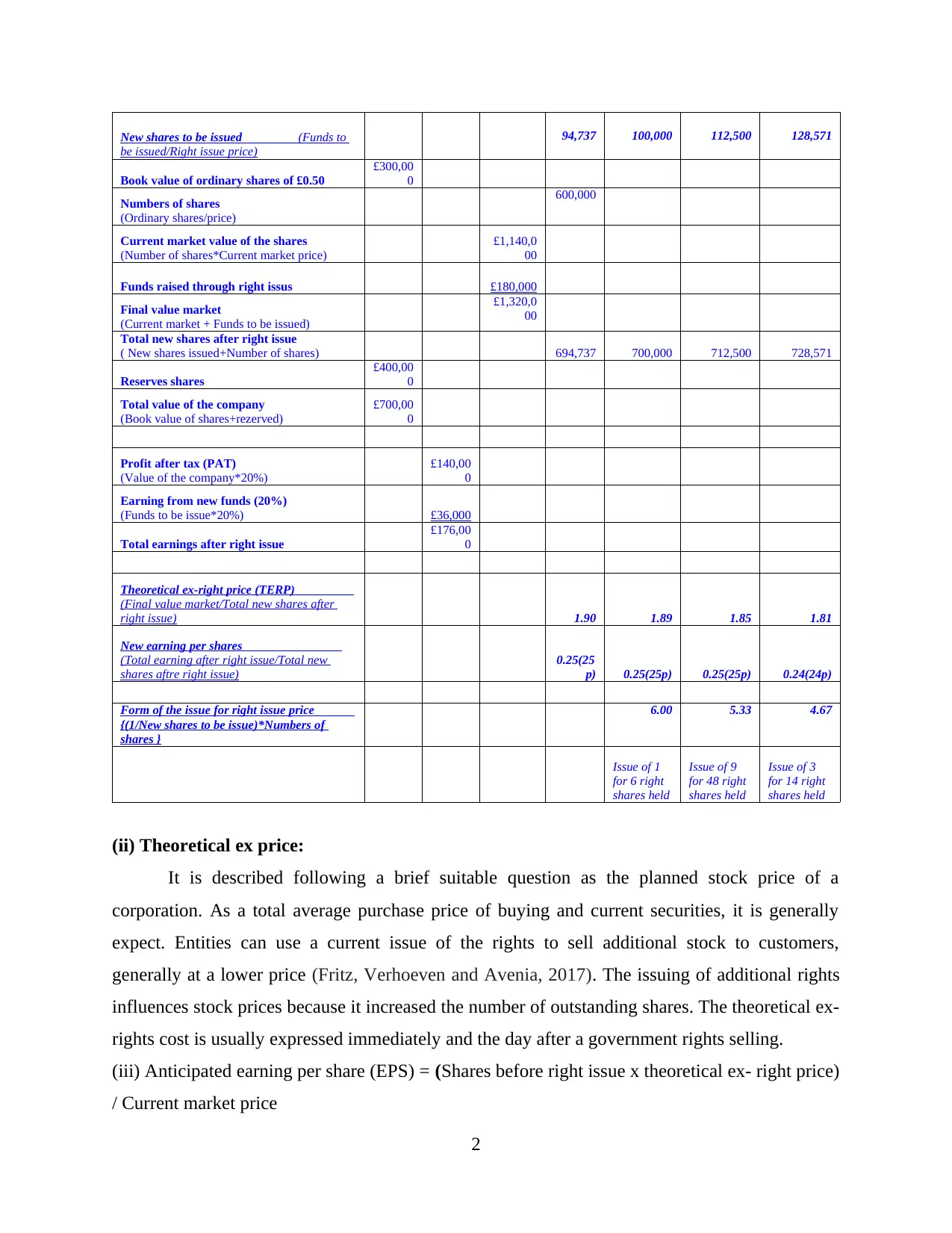
New shares to be issued (Funds to
be issued/Right issue price)
94,737 100,000 112,500 128,571
Book value of ordinary shares of £0.50
£300,00
0
Numbers of shares
(Ordinary shares/price)
600,000
Current market value of the shares
(Number of shares*Current market price)
£1,140,0
00
Funds raised through right issus £180,000
Final value market
(Current market + Funds to be issued)
£1,320,0
00
Total new shares after right issue
( New shares issued+Number of shares) 694,737 700,000 712,500 728,571
Reserves shares
£400,00
0
Total value of the company
(Book value of shares+rezerved)
£700,00
0
Profit after tax (PAT)
(Value of the company*20%)
£140,00
0
Earning from new funds (20%)
(Funds to be issue*20%) £36,000
Total earnings after right issue
£176,00
0
Theoretical ex-right price (TERP)
(Final value market/Total new shares after
right issue) 1.90 1.89 1.85 1.81
New earning per shares
(Total earning after right issue/Total new
shares aftre right issue)
0.25(25
p) 0.25(25p) 0.25(25p) 0.24(24p)
Form of the issue for right issue price
{(1/New shares to be issue)*Numbers of
shares }
6.00 5.33 4.67
Issue of 1
for 6 right
shares held
Issue of 9
for 48 right
shares held
Issue of 3
for 14 right
shares held
(ii) Theoretical ex price:
It is described following a brief suitable question as the planned stock price of a
corporation. As a total average purchase price of buying and current securities, it is generally
expect. Entities can use a current issue of the rights to sell additional stock to customers,
generally at a lower price (Fritz, Verhoeven and Avenia, 2017). The issuing of additional rights
influences stock prices because it increased the number of outstanding shares. The theoretical ex-
rights cost is usually expressed immediately and the day after a government rights selling.
(iii) Anticipated earning per share (EPS) = (Shares before right issue x theoretical ex- right price)
/ Current market price
2
be issued/Right issue price)
94,737 100,000 112,500 128,571
Book value of ordinary shares of £0.50
£300,00
0
Numbers of shares
(Ordinary shares/price)
600,000
Current market value of the shares
(Number of shares*Current market price)
£1,140,0
00
Funds raised through right issus £180,000
Final value market
(Current market + Funds to be issued)
£1,320,0
00
Total new shares after right issue
( New shares issued+Number of shares) 694,737 700,000 712,500 728,571
Reserves shares
£400,00
0
Total value of the company
(Book value of shares+rezerved)
£700,00
0
Profit after tax (PAT)
(Value of the company*20%)
£140,00
0
Earning from new funds (20%)
(Funds to be issue*20%) £36,000
Total earnings after right issue
£176,00
0
Theoretical ex-right price (TERP)
(Final value market/Total new shares after
right issue) 1.90 1.89 1.85 1.81
New earning per shares
(Total earning after right issue/Total new
shares aftre right issue)
0.25(25
p) 0.25(25p) 0.25(25p) 0.24(24p)
Form of the issue for right issue price
{(1/New shares to be issue)*Numbers of
shares }
6.00 5.33 4.67
Issue of 1
for 6 right
shares held
Issue of 9
for 48 right
shares held
Issue of 3
for 14 right
shares held
(ii) Theoretical ex price:
It is described following a brief suitable question as the planned stock price of a
corporation. As a total average purchase price of buying and current securities, it is generally
expect. Entities can use a current issue of the rights to sell additional stock to customers,
generally at a lower price (Fritz, Verhoeven and Avenia, 2017). The issuing of additional rights
influences stock prices because it increased the number of outstanding shares. The theoretical ex-
rights cost is usually expressed immediately and the day after a government rights selling.
(iii) Anticipated earning per share (EPS) = (Shares before right issue x theoretical ex- right price)
/ Current market price
2

Thus,
Market rate= > 1.9
Available share= > 600000
Return on shareholder fund = > 140000
(iv) Form of issue of right issue price:
Critical evaluation:
Issue of every right share rates:
Of every share, the number of organizationally enhanced stocks would be 100,000 shares
in the 1.80 right issue. As a consequence, shareholders must allocate the pro-rata 1 share
to the remaining six shares.
In the context of every share the total share developed by the company in future would be
112500 in the regard of right share of 1.60 (Goel, Chadha and Sharma, 2015). Therefore
the resulted pro-rata 9 right share might be allotted to respective parties in the context of
48 share.
The total sum of share must be improve by the company in upcoming year would be
(v) Evaluate the best option from three right issue:
From the above discussion it has been founded that estimated value which issue @ £ 1.8
that is beneficial for the organization (Throsby, 2016). Because, estimation cost of earning per
share (EPS) is higher than the other two options prices.
(c) Evaluate the benefits of scrip divided in context of shareholders or companies
Scrip dividend: This term refer to the new shares of issuer's stock which issues to the
shareholders rather than providing dividend. Basically it is organization offer the shares to the
shareholders in terms of cash dividend which further automatically maximise the number of
shares as well as dividend. When any firm offer scrip dividend than it means, they provide the
opportunity to the people to maximise their shares without any additional fees or charges. This
method used by the corporation when they have to pay their inventors but they does not have
sufficient money for this (Guess and Ma, 2015). It is basically apply for the newly generated
stocks in comparison to the existing one. In many cases, it will be consider as a form of debt
which has some benefits as well as drawbacks in context of organization as well as shareholders.
Further evaluation discussed below:
3
Market rate= > 1.9
Available share= > 600000
Return on shareholder fund = > 140000
(iv) Form of issue of right issue price:
Critical evaluation:
Issue of every right share rates:
Of every share, the number of organizationally enhanced stocks would be 100,000 shares
in the 1.80 right issue. As a consequence, shareholders must allocate the pro-rata 1 share
to the remaining six shares.
In the context of every share the total share developed by the company in future would be
112500 in the regard of right share of 1.60 (Goel, Chadha and Sharma, 2015). Therefore
the resulted pro-rata 9 right share might be allotted to respective parties in the context of
48 share.
The total sum of share must be improve by the company in upcoming year would be
(v) Evaluate the best option from three right issue:
From the above discussion it has been founded that estimated value which issue @ £ 1.8
that is beneficial for the organization (Throsby, 2016). Because, estimation cost of earning per
share (EPS) is higher than the other two options prices.
(c) Evaluate the benefits of scrip divided in context of shareholders or companies
Scrip dividend: This term refer to the new shares of issuer's stock which issues to the
shareholders rather than providing dividend. Basically it is organization offer the shares to the
shareholders in terms of cash dividend which further automatically maximise the number of
shares as well as dividend. When any firm offer scrip dividend than it means, they provide the
opportunity to the people to maximise their shares without any additional fees or charges. This
method used by the corporation when they have to pay their inventors but they does not have
sufficient money for this (Guess and Ma, 2015). It is basically apply for the newly generated
stocks in comparison to the existing one. In many cases, it will be consider as a form of debt
which has some benefits as well as drawbacks in context of organization as well as shareholders.
Further evaluation discussed below:
3
⊘ This is a preview!⊘
Do you want full access?
Subscribe today to unlock all pages.

Trusted by 1+ million students worldwide
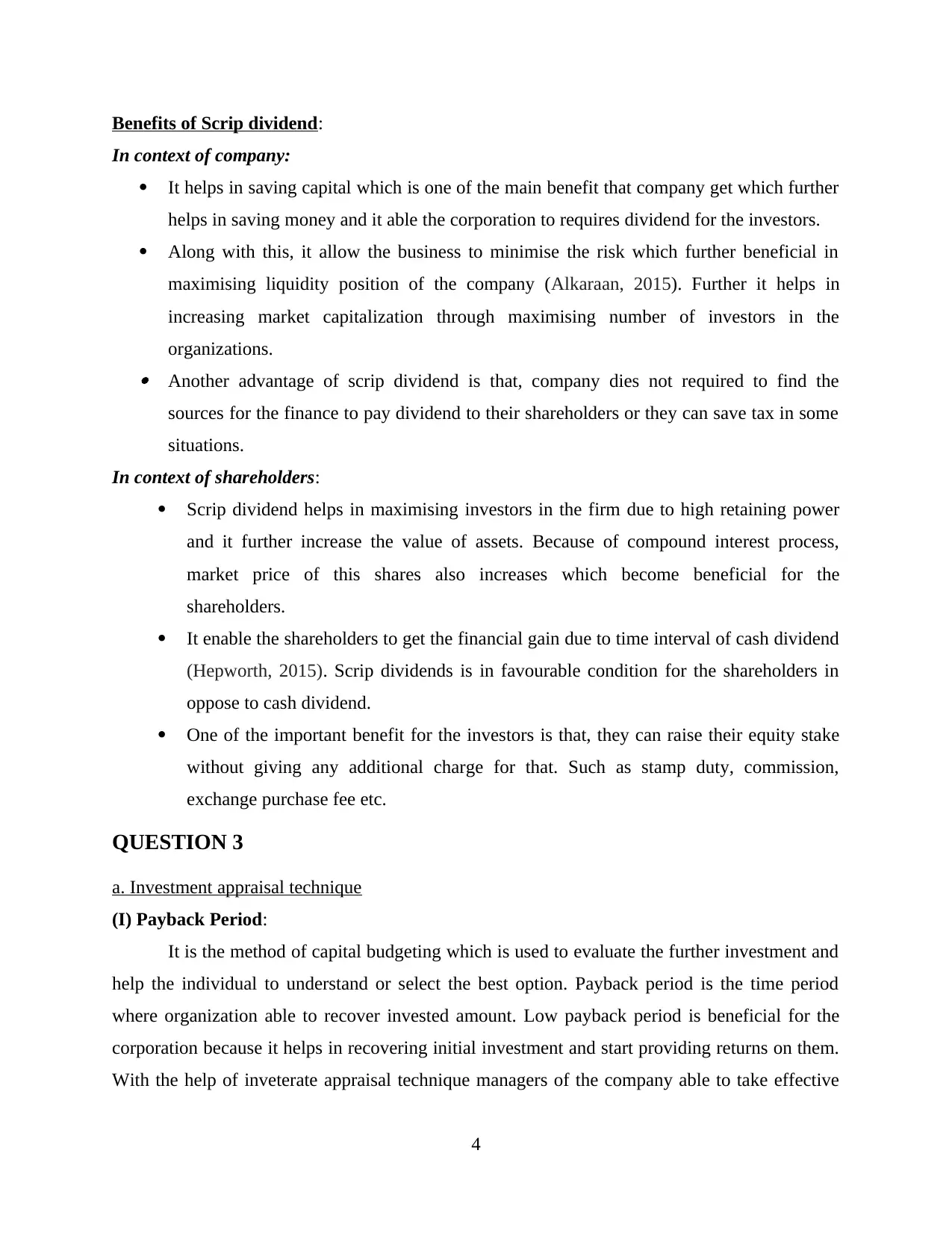
Benefits of Scrip dividend:
In context of company:
It helps in saving capital which is one of the main benefit that company get which further
helps in saving money and it able the corporation to requires dividend for the investors.
Along with this, it allow the business to minimise the risk which further beneficial in
maximising liquidity position of the company (Alkaraan, 2015). Further it helps in
increasing market capitalization through maximising number of investors in the
organizations. Another advantage of scrip dividend is that, company dies not required to find the
sources for the finance to pay dividend to their shareholders or they can save tax in some
situations.
In context of shareholders:
Scrip dividend helps in maximising investors in the firm due to high retaining power
and it further increase the value of assets. Because of compound interest process,
market price of this shares also increases which become beneficial for the
shareholders.
It enable the shareholders to get the financial gain due to time interval of cash dividend
(Hepworth, 2015). Scrip dividends is in favourable condition for the shareholders in
oppose to cash dividend.
One of the important benefit for the investors is that, they can raise their equity stake
without giving any additional charge for that. Such as stamp duty, commission,
exchange purchase fee etc.
QUESTION 3
a. Investment appraisal technique
(I) Payback Period:
It is the method of capital budgeting which is used to evaluate the further investment and
help the individual to understand or select the best option. Payback period is the time period
where organization able to recover invested amount. Low payback period is beneficial for the
corporation because it helps in recovering initial investment and start providing returns on them.
With the help of inveterate appraisal technique managers of the company able to take effective
4
In context of company:
It helps in saving capital which is one of the main benefit that company get which further
helps in saving money and it able the corporation to requires dividend for the investors.
Along with this, it allow the business to minimise the risk which further beneficial in
maximising liquidity position of the company (Alkaraan, 2015). Further it helps in
increasing market capitalization through maximising number of investors in the
organizations. Another advantage of scrip dividend is that, company dies not required to find the
sources for the finance to pay dividend to their shareholders or they can save tax in some
situations.
In context of shareholders:
Scrip dividend helps in maximising investors in the firm due to high retaining power
and it further increase the value of assets. Because of compound interest process,
market price of this shares also increases which become beneficial for the
shareholders.
It enable the shareholders to get the financial gain due to time interval of cash dividend
(Hepworth, 2015). Scrip dividends is in favourable condition for the shareholders in
oppose to cash dividend.
One of the important benefit for the investors is that, they can raise their equity stake
without giving any additional charge for that. Such as stamp duty, commission,
exchange purchase fee etc.
QUESTION 3
a. Investment appraisal technique
(I) Payback Period:
It is the method of capital budgeting which is used to evaluate the further investment and
help the individual to understand or select the best option. Payback period is the time period
where organization able to recover invested amount. Low payback period is beneficial for the
corporation because it helps in recovering initial investment and start providing returns on them.
With the help of inveterate appraisal technique managers of the company able to take effective
4
Paraphrase This Document
Need a fresh take? Get an instant paraphrase of this document with our AI Paraphraser
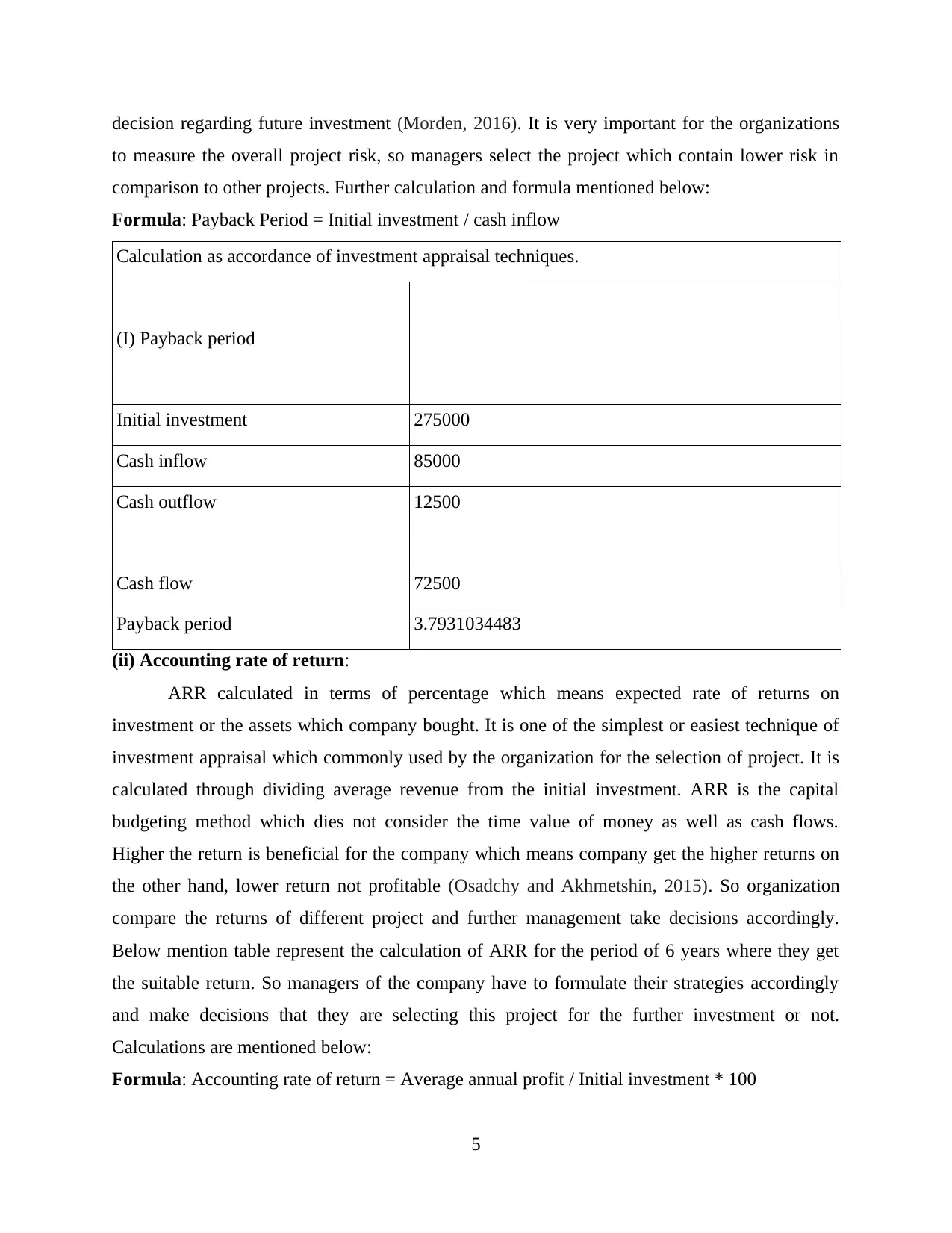
decision regarding future investment (Morden, 2016). It is very important for the organizations
to measure the overall project risk, so managers select the project which contain lower risk in
comparison to other projects. Further calculation and formula mentioned below:
Formula: Payback Period = Initial investment / cash inflow
Calculation as accordance of investment appraisal techniques.
(I) Payback period
Initial investment 275000
Cash inflow 85000
Cash outflow 12500
Cash flow 72500
Payback period 3.7931034483
(ii) Accounting rate of return:
ARR calculated in terms of percentage which means expected rate of returns on
investment or the assets which company bought. It is one of the simplest or easiest technique of
investment appraisal which commonly used by the organization for the selection of project. It is
calculated through dividing average revenue from the initial investment. ARR is the capital
budgeting method which dies not consider the time value of money as well as cash flows.
Higher the return is beneficial for the company which means company get the higher returns on
the other hand, lower return not profitable (Osadchy and Akhmetshin, 2015). So organization
compare the returns of different project and further management take decisions accordingly.
Below mention table represent the calculation of ARR for the period of 6 years where they get
the suitable return. So managers of the company have to formulate their strategies accordingly
and make decisions that they are selecting this project for the further investment or not.
Calculations are mentioned below:
Formula: Accounting rate of return = Average annual profit / Initial investment * 100
5
to measure the overall project risk, so managers select the project which contain lower risk in
comparison to other projects. Further calculation and formula mentioned below:
Formula: Payback Period = Initial investment / cash inflow
Calculation as accordance of investment appraisal techniques.
(I) Payback period
Initial investment 275000
Cash inflow 85000
Cash outflow 12500
Cash flow 72500
Payback period 3.7931034483
(ii) Accounting rate of return:
ARR calculated in terms of percentage which means expected rate of returns on
investment or the assets which company bought. It is one of the simplest or easiest technique of
investment appraisal which commonly used by the organization for the selection of project. It is
calculated through dividing average revenue from the initial investment. ARR is the capital
budgeting method which dies not consider the time value of money as well as cash flows.
Higher the return is beneficial for the company which means company get the higher returns on
the other hand, lower return not profitable (Osadchy and Akhmetshin, 2015). So organization
compare the returns of different project and further management take decisions accordingly.
Below mention table represent the calculation of ARR for the period of 6 years where they get
the suitable return. So managers of the company have to formulate their strategies accordingly
and make decisions that they are selecting this project for the further investment or not.
Calculations are mentioned below:
Formula: Accounting rate of return = Average annual profit / Initial investment * 100
5
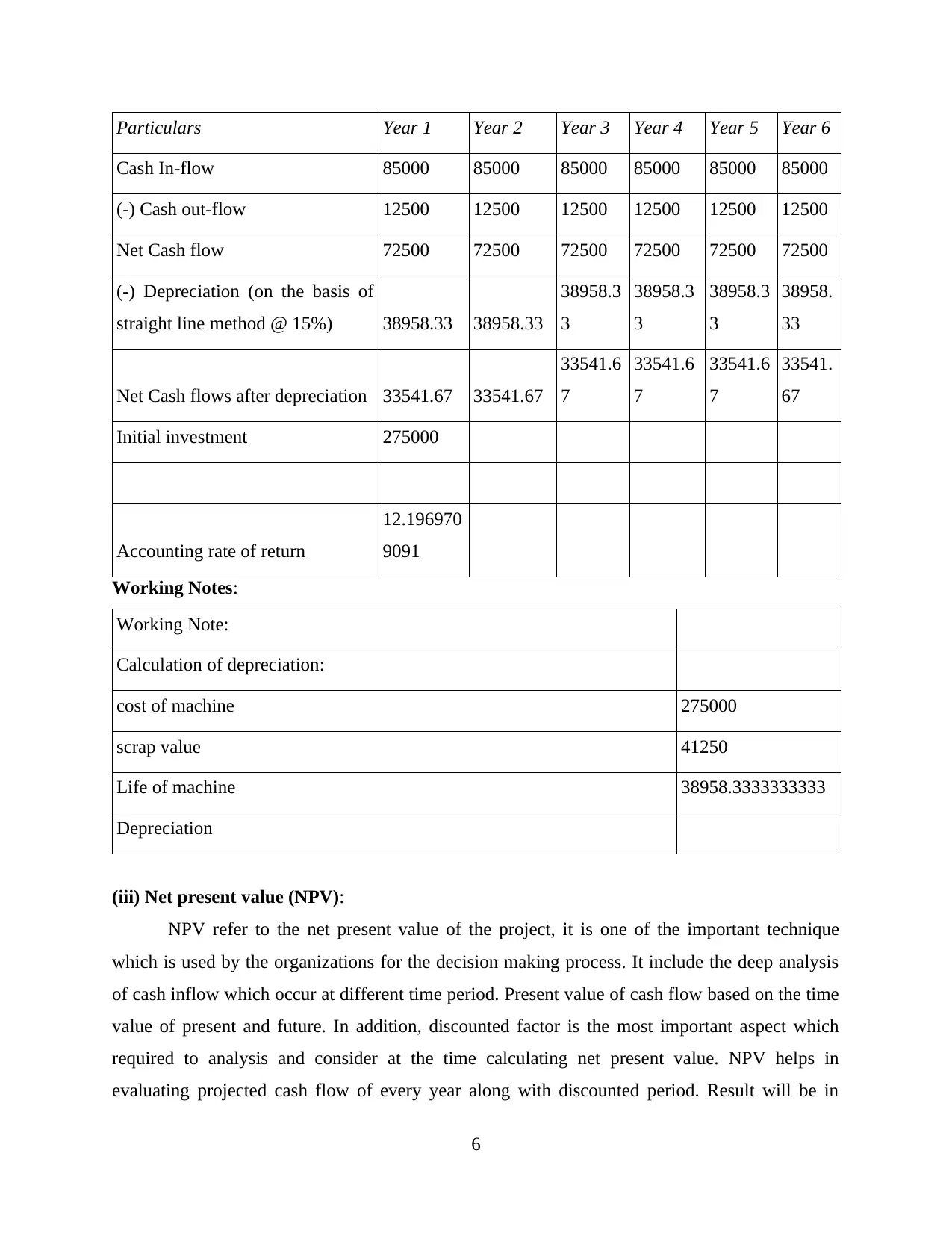
Particulars Year 1 Year 2 Year 3 Year 4 Year 5 Year 6
Cash In-flow 85000 85000 85000 85000 85000 85000
(-) Cash out-flow 12500 12500 12500 12500 12500 12500
Net Cash flow 72500 72500 72500 72500 72500 72500
(-) Depreciation (on the basis of
straight line method @ 15%) 38958.33 38958.33
38958.3
3
38958.3
3
38958.3
3
38958.
33
Net Cash flows after depreciation 33541.67 33541.67
33541.6
7
33541.6
7
33541.6
7
33541.
67
Initial investment 275000
Accounting rate of return
12.196970
9091
Working Notes:
Working Note:
Calculation of depreciation:
cost of machine 275000
scrap value 41250
Life of machine 38958.3333333333
Depreciation
(iii) Net present value (NPV):
NPV refer to the net present value of the project, it is one of the important technique
which is used by the organizations for the decision making process. It include the deep analysis
of cash inflow which occur at different time period. Present value of cash flow based on the time
value of present and future. In addition, discounted factor is the most important aspect which
required to analysis and consider at the time calculating net present value. NPV helps in
evaluating projected cash flow of every year along with discounted period. Result will be in
6
Cash In-flow 85000 85000 85000 85000 85000 85000
(-) Cash out-flow 12500 12500 12500 12500 12500 12500
Net Cash flow 72500 72500 72500 72500 72500 72500
(-) Depreciation (on the basis of
straight line method @ 15%) 38958.33 38958.33
38958.3
3
38958.3
3
38958.3
3
38958.
33
Net Cash flows after depreciation 33541.67 33541.67
33541.6
7
33541.6
7
33541.6
7
33541.
67
Initial investment 275000
Accounting rate of return
12.196970
9091
Working Notes:
Working Note:
Calculation of depreciation:
cost of machine 275000
scrap value 41250
Life of machine 38958.3333333333
Depreciation
(iii) Net present value (NPV):
NPV refer to the net present value of the project, it is one of the important technique
which is used by the organizations for the decision making process. It include the deep analysis
of cash inflow which occur at different time period. Present value of cash flow based on the time
value of present and future. In addition, discounted factor is the most important aspect which
required to analysis and consider at the time calculating net present value. NPV helps in
evaluating projected cash flow of every year along with discounted period. Result will be in
6
⊘ This is a preview!⊘
Do you want full access?
Subscribe today to unlock all pages.

Trusted by 1+ million students worldwide
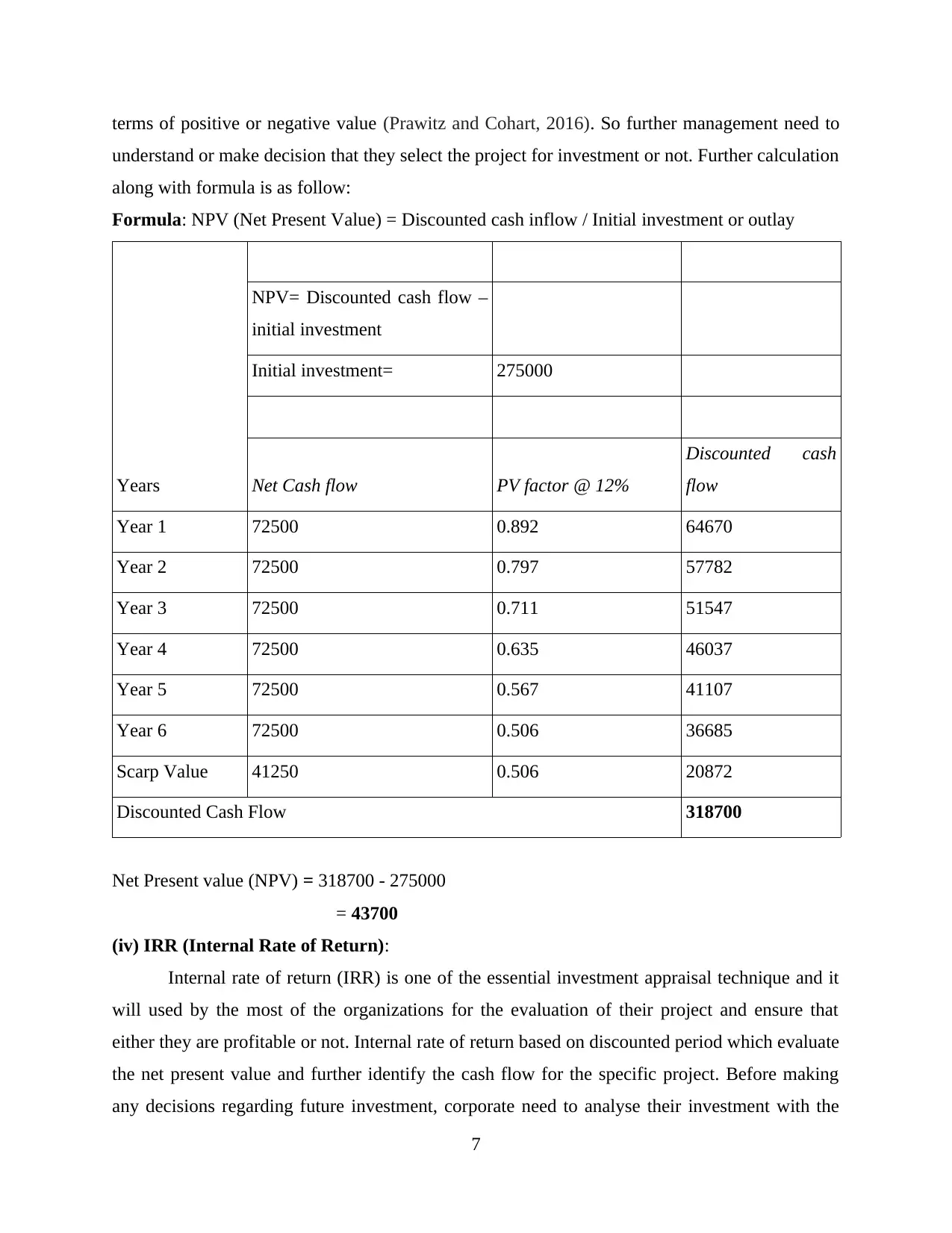
terms of positive or negative value (Prawitz and Cohart, 2016). So further management need to
understand or make decision that they select the project for investment or not. Further calculation
along with formula is as follow:
Formula: NPV (Net Present Value) = Discounted cash inflow / Initial investment or outlay
Years
NPV= Discounted cash flow –
initial investment
Initial investment= 275000
Net Cash flow PV factor @ 12%
Discounted cash
flow
Year 1 72500 0.892 64670
Year 2 72500 0.797 57782
Year 3 72500 0.711 51547
Year 4 72500 0.635 46037
Year 5 72500 0.567 41107
Year 6 72500 0.506 36685
Scarp Value 41250 0.506 20872
Discounted Cash Flow 318700
Net Present value (NPV) = 318700 - 275000
= 43700
(iv) IRR (Internal Rate of Return):
Internal rate of return (IRR) is one of the essential investment appraisal technique and it
will used by the most of the organizations for the evaluation of their project and ensure that
either they are profitable or not. Internal rate of return based on discounted period which evaluate
the net present value and further identify the cash flow for the specific project. Before making
any decisions regarding future investment, corporate need to analyse their investment with the
7
understand or make decision that they select the project for investment or not. Further calculation
along with formula is as follow:
Formula: NPV (Net Present Value) = Discounted cash inflow / Initial investment or outlay
Years
NPV= Discounted cash flow –
initial investment
Initial investment= 275000
Net Cash flow PV factor @ 12%
Discounted cash
flow
Year 1 72500 0.892 64670
Year 2 72500 0.797 57782
Year 3 72500 0.711 51547
Year 4 72500 0.635 46037
Year 5 72500 0.567 41107
Year 6 72500 0.506 36685
Scarp Value 41250 0.506 20872
Discounted Cash Flow 318700
Net Present value (NPV) = 318700 - 275000
= 43700
(iv) IRR (Internal Rate of Return):
Internal rate of return (IRR) is one of the essential investment appraisal technique and it
will used by the most of the organizations for the evaluation of their project and ensure that
either they are profitable or not. Internal rate of return based on discounted period which evaluate
the net present value and further identify the cash flow for the specific project. Before making
any decisions regarding future investment, corporate need to analyse their investment with the
7
Paraphrase This Document
Need a fresh take? Get an instant paraphrase of this document with our AI Paraphraser
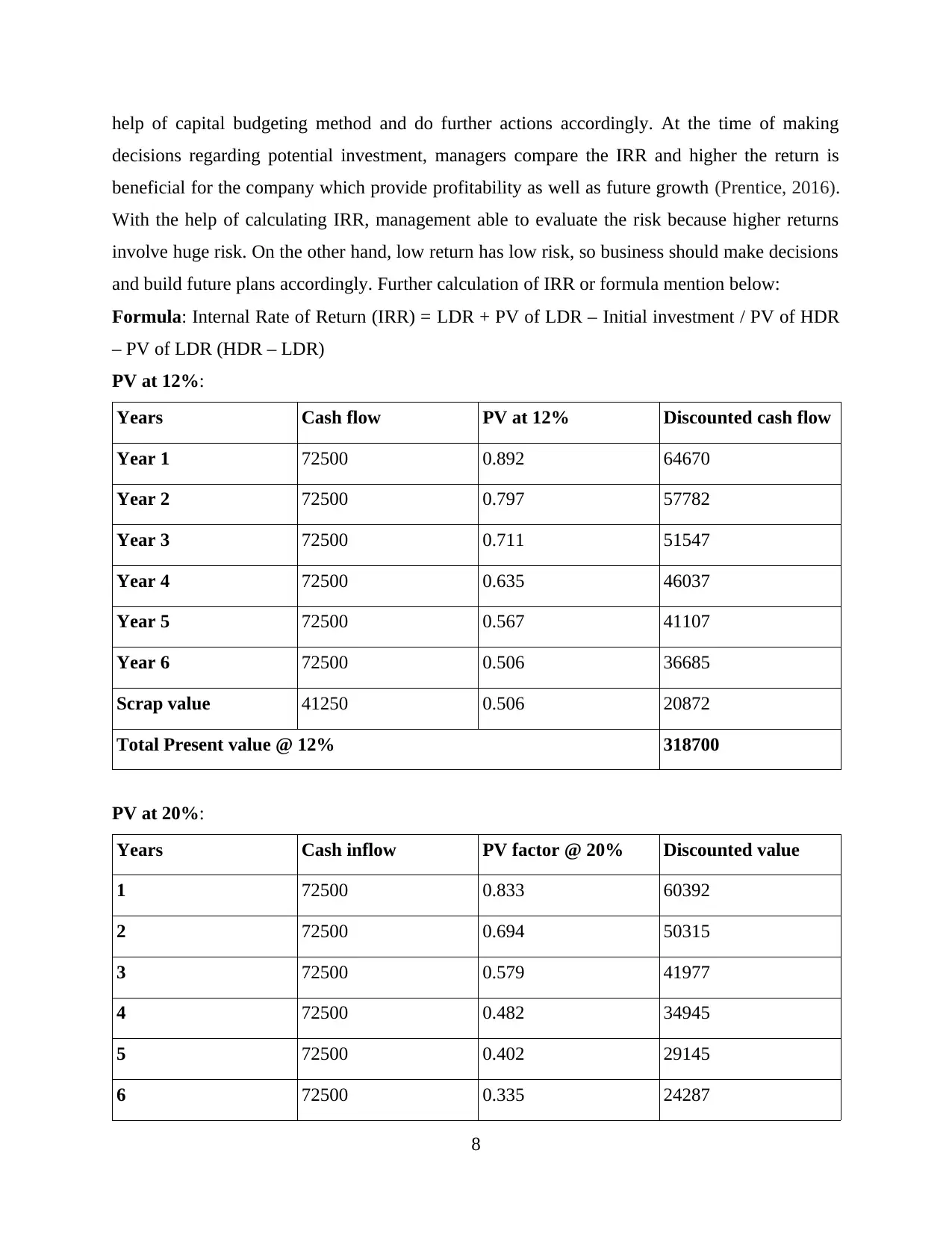
help of capital budgeting method and do further actions accordingly. At the time of making
decisions regarding potential investment, managers compare the IRR and higher the return is
beneficial for the company which provide profitability as well as future growth (Prentice, 2016).
With the help of calculating IRR, management able to evaluate the risk because higher returns
involve huge risk. On the other hand, low return has low risk, so business should make decisions
and build future plans accordingly. Further calculation of IRR or formula mention below:
Formula: Internal Rate of Return (IRR) = LDR + PV of LDR – Initial investment / PV of HDR
– PV of LDR (HDR – LDR)
PV at 12%:
Years Cash flow PV at 12% Discounted cash flow
Year 1 72500 0.892 64670
Year 2 72500 0.797 57782
Year 3 72500 0.711 51547
Year 4 72500 0.635 46037
Year 5 72500 0.567 41107
Year 6 72500 0.506 36685
Scrap value 41250 0.506 20872
Total Present value @ 12% 318700
PV at 20%:
Years Cash inflow PV factor @ 20% Discounted value
1 72500 0.833 60392
2 72500 0.694 50315
3 72500 0.579 41977
4 72500 0.482 34945
5 72500 0.402 29145
6 72500 0.335 24287
8
decisions regarding potential investment, managers compare the IRR and higher the return is
beneficial for the company which provide profitability as well as future growth (Prentice, 2016).
With the help of calculating IRR, management able to evaluate the risk because higher returns
involve huge risk. On the other hand, low return has low risk, so business should make decisions
and build future plans accordingly. Further calculation of IRR or formula mention below:
Formula: Internal Rate of Return (IRR) = LDR + PV of LDR – Initial investment / PV of HDR
– PV of LDR (HDR – LDR)
PV at 12%:
Years Cash flow PV at 12% Discounted cash flow
Year 1 72500 0.892 64670
Year 2 72500 0.797 57782
Year 3 72500 0.711 51547
Year 4 72500 0.635 46037
Year 5 72500 0.567 41107
Year 6 72500 0.506 36685
Scrap value 41250 0.506 20872
Total Present value @ 12% 318700
PV at 20%:
Years Cash inflow PV factor @ 20% Discounted value
1 72500 0.833 60392
2 72500 0.694 50315
3 72500 0.579 41977
4 72500 0.482 34945
5 72500 0.402 29145
6 72500 0.335 24287
8

Scrap value 41250 0.335 13818
Total Present value @ 20% 254880
Interval Rate of Return (IRR) = 12 + ( 318703 – 275000 ) / ( 254881 – 318703 ) * ( 20 – 12 )
= 12 + 43703 / -63881 * ( 8 )
= 12 + ( -0.68 ) * 8
= 12 – 5.44
= 6.56 %
Recommendation:
From the above observation it has been recommended that, if Lovewell company bought
new machinery for business operations then it will beneficial for them as well as profitable.
Because it has been analysed that if Lovewell invest in the new machinery then the payback
period of this project is 3.79 years. It means, company recover the amount in the approx 4 years
and the accounting rate of return was 12.19 %. It is observed that, ARR is in favourable
condition which means, if they invest in this project so they get the around 12 % return which is
very good as well as profitable for the business(Rampini, Viswanathan and Vuillemey, 2019).
Net present value of the company is 43700 which is positive that means investment in this
machinery is beneficial for Lovewell company. IRR of this project is 6.56% that is also good
enough to invest in new machinery or maximise the productivity as well as profitability of the
business. With the help of above mention results, managers able to make decision in favour of
this project that is beneficial for the organization to invest in the new machinery for the better
production.
b. Critical evaluation of investment appraisal techniques with the help of its benefits &
drawbacks
Payback period:
Benefits:
simple to use and easy to understand, this method is use to calculate time period of the
project for the management term (Harris, 2017). This required initial cost and annual cash
flows for the getting the period of the project. This methods include few inputs and
easier method to calculate the capital budgeting method.
9
Total Present value @ 20% 254880
Interval Rate of Return (IRR) = 12 + ( 318703 – 275000 ) / ( 254881 – 318703 ) * ( 20 – 12 )
= 12 + 43703 / -63881 * ( 8 )
= 12 + ( -0.68 ) * 8
= 12 – 5.44
= 6.56 %
Recommendation:
From the above observation it has been recommended that, if Lovewell company bought
new machinery for business operations then it will beneficial for them as well as profitable.
Because it has been analysed that if Lovewell invest in the new machinery then the payback
period of this project is 3.79 years. It means, company recover the amount in the approx 4 years
and the accounting rate of return was 12.19 %. It is observed that, ARR is in favourable
condition which means, if they invest in this project so they get the around 12 % return which is
very good as well as profitable for the business(Rampini, Viswanathan and Vuillemey, 2019).
Net present value of the company is 43700 which is positive that means investment in this
machinery is beneficial for Lovewell company. IRR of this project is 6.56% that is also good
enough to invest in new machinery or maximise the productivity as well as profitability of the
business. With the help of above mention results, managers able to make decision in favour of
this project that is beneficial for the organization to invest in the new machinery for the better
production.
b. Critical evaluation of investment appraisal techniques with the help of its benefits &
drawbacks
Payback period:
Benefits:
simple to use and easy to understand, this method is use to calculate time period of the
project for the management term (Harris, 2017). This required initial cost and annual cash
flows for the getting the period of the project. This methods include few inputs and
easier method to calculate the capital budgeting method.
9
⊘ This is a preview!⊘
Do you want full access?
Subscribe today to unlock all pages.

Trusted by 1+ million students worldwide
1 out of 15
Related Documents
Your All-in-One AI-Powered Toolkit for Academic Success.
+13062052269
info@desklib.com
Available 24*7 on WhatsApp / Email
![[object Object]](/_next/static/media/star-bottom.7253800d.svg)
Unlock your academic potential
Copyright © 2020–2026 A2Z Services. All Rights Reserved. Developed and managed by ZUCOL.





